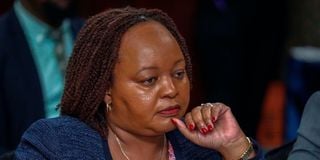Premium
Senators question loss of water worth Sh470 million in Kirinyaga

Kirinyaga Governor Anne Waiguru before the Senate Committee on County Public Investments and Special Funds at KICC, Nairobi County on Wednesday, May 17, 2023.
Kirinyaga Governor Anne Waiguru was yesterday hard-pressed to explain why the county’s water utility firm cannot account for Sh470.6 million lost through non-revenue water.
Ms Waiguru was taken to task by the Senate County Public Investment and Special Funds committee over the Kirinyaga Water and Sanitation Company (Kirwasco) failure to account for 60 per cent of the water it produces, adversely affecting its profitability.
The governor was appearing before the considering audit queries raised by.
According to a report by Auditor-General Nancy Gathungu on Kirwasco’s operations in the financial year ended June 2021, the firm produced 6,722,945 cubic metres of water but only 2,701,482 cubic metres was billed to customers at Sh150.8 million.
The balance of 4,021,463 cubic metres, approximately 60 per cent of the total production, was captured as unaccounted for. The percentage is way above the sector-recommended limit of 25 per cent as per the Water Services Regulatory Board (Wasreb) guidelines.
Ms Gathungu said the non-revenue water, which is 35 per cent above the allowable loss, resulted in a loss of Sh470.6 million.
The audit report also stated that the company has been operating without an approved water tariff structure from Wasreb since the financial year ended 2020 following the expiry of the old one.
“In the circumstances, the non-updating of water tariffs results in lower revenue streams in addition to the lower customer deposits, which may be inadequate to cover unpaid bills in case of default,” reads the report in part.
Dilapidated infrastructure
However, Ms Waiguru told the Vihiga Senator Godfrey Osotsi-led committee that the high non-revenue water is caused by both physical and commercial losses resulting from old and dilapidated infrastructure.
She cited the example of the Githioro water supply system, which was constructed in 1940 with a design population of 2,500 people but now supports 12,000 people.
“We have initiated key reforms in the entity to streamline and enhance water services. The company has developed a non-revenue water reduction plan while also shifting from UPVC to HDPE pipes which are more durable,” said Ms Waiguru.
However, the committee members were not convinced with the response, saying that it is through non-revenue water that officials of the water company embezzle funds.
“It is through non-revenue water that the officials of the water company embezzle funds. How does the design of 1940 to support 2,500 people but now serving 12,000 affect water revenue?” asked Kiambu Senator Karungo Thang’wa.
But Ms Waiguru defended her administration against the accusations, asking the committee to give her team more time to replace the old line and reduce the non-revenue water.
On the old water tariffs, she said the firm has initiated the process of renewal by gazetting new tariffs in early February.





